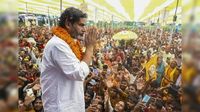Political tensions in Bihar are running high as the state gears up for its 2025 Assembly elections, with alliances on both sides of the aisle facing internal strife and uncertainty. On October 15, 2025, Prashant Kishor, the founder of Jan Suraaj Party and a seasoned political strategist, delivered a bold prediction: the ruling National Democratic Alliance (NDA) is headed for certain defeat. According to a series of interviews with PTI, Kishor’s forecast comes amid an atmosphere of chaos and shifting allegiances, not just within the NDA but also in the opposition INDIA bloc, setting the stage for one of the most unpredictable elections in recent Bihar history.
Kishor, who has long been a key figure in Indian electoral politics and once worked closely with Chief Minister Nitish Kumar and his Janata Dal (United) or JD(U), did not mince words. He asserted, "The NDA is undoubtedly on its way out, and Nitish Kumar will not return as chief minister." His assessment is rooted in the coalition’s inability to finalize seat-sharing arrangements and candidate lists—a process that has dragged on with little clarity, raising doubts about the alliance’s organizational strength.
This sense of disarray is not limited to the ruling coalition. Kishor highlighted that "complete chaos" reigns within the NDA, particularly over which seats the Bharatiya Janata Party (BJP) and JD(U) will contest. He remarked, "One doesn't need to be a psephologist to understand the JD(U)'s predicament." The memory of the last assembly elections looms large: Chirag Paswan, leader of the Lok Janshakti Party (LJP), staged a last-minute revolt, fielding candidates against JD(U) nominees, a move that saw JD(U)'s tally plummet to just 43 seats out of 243. This time, Kishor believes, the situation has only worsened for Nitish Kumar’s party, predicting it will struggle to win even 25 seats.
According to a special report from Editorji, the NDA has finally cobbled together a seat-sharing formula: both BJP and JD(U) will contest 101 seats each, while the LJP (Ram Vilas) gets 29, and the Hindustani Awam Morcha (HAM) and Rashtriya Lok Morcha (RLM) receive six seats each. This arrangement marks a significant shift in JD(U)’s standing, reducing its traditional dominance within the alliance. Meanwhile, the BJP has released its first list of 71 candidates, featuring prominent names such as Deputy Chief Ministers Samrat Chaudhary and Vijay Kumar Sinha. Chirag Paswan’s growing influence is unmistakable, with a key LJP (Ram Vilas) leader stating, "Our association is with the BJP, frankly. There is no difference between us and them."
But this carefully balanced formula has not quelled the unrest. The process of finalizing candidates has been fraught with delays, fueling speculation about the NDA’s unity and readiness. Kishor’s critique that "uncertainty over which seats the BJP will contest and where the JD(U) plans to position its candidates" persists, despite the public announcement of the seat-sharing deal. The tension is palpable, and the risk of further rebellion within the alliance remains high.
The opposition Mahagathbandhan, or Grand Alliance, is hardly faring better. Talks between the Rashtriya Janata Dal (RJD) and the Congress party remain deadlocked, with both sides unable to reach a consensus on seat distribution. The Communist Party of India (Marxist-Leninist) or CPI(ML), another key player in the alliance, has withdrawn its candidate list amidst the uncertainty, further complicating the opposition’s electoral calculus. Kishor observed, "The situation is no better within the INDIA bloc, either. A recurring tiff between the RJD and the Congress prevails, and the allegiance of former state minister Mukesh Sahani’s Vikassheel Insaan Party remains unclear."
This climate of indecision and infighting has left both alliances vulnerable. The electorate, already skeptical of grand coalition promises, is now faced with a political landscape where alliances seem more fragile than ever. As Kishor put it, "You do not need to be a psephologist to fathom what is in store for the JD(U)." His comments reflect a broader sentiment of frustration and fatigue among voters, many of whom have witnessed similar dramas play out in previous election cycles.
Amidst all this, Prashant Kishor himself has put to rest months of speculation about his own electoral ambitions. In an interview with PTI, he announced that he will not contest the upcoming Bihar Assembly elections, choosing instead to focus on strengthening his party’s organizational base. "My party, Jan Suraaj, has decided I should focus on organisational work," he explained. This move underscores Kishor’s belief that the real battle in Bihar is not just about winning seats, but about building sustainable political structures capable of enduring the state’s notoriously volatile electoral landscape.
The volatility of this election season is further heightened by external factors. As reported by Editorji, the International Monetary Fund (IMF) recently raised India’s GDP growth forecast for 2025-26 to 6.6%, up from 6.4%. This revision was prompted by a strong first quarter performance, which offset the impact of increased US tariffs on Indian goods. While the forecast for the current fiscal year is positive, the projection for 2026-27 has been lowered to 6.2%. This economic backdrop adds another layer of complexity to the elections, as political parties must address not only internal challenges but also the broader questions of economic resilience and trade.
For Chief Minister Nitish Kumar, the stakes could not be higher. Having weathered multiple political storms and alliance reshuffles, he now faces mounting criticism from both allies and opponents. Kishor’s assertion that "Nitish Kumar will not return as chief minister" is a direct challenge to the incumbent’s authority and legacy. The JD(U), once the dominant force in Bihar politics, finds itself squeezed between a resurgent BJP and restive allies, with its traditional base showing signs of erosion.
On the other side, the Mahagathbandhan’s inability to present a united front could cost it dearly. The RJD and Congress, despite years of collaboration, seem unable to overcome their differences, while smaller parties like the CPI(ML) and Vikassheel Insaan Party weigh their options. The electorate, meanwhile, is left to navigate a bewildering array of alliances, defections, and last-minute deals.
As Bihar heads into the 2025 Assembly elections, the only certainty appears to be uncertainty itself. With alliances fraying and leaders like Prashant Kishor sounding the alarm, the coming weeks promise high drama and, perhaps, a political realignment that could reshape the state’s future for years to come.

